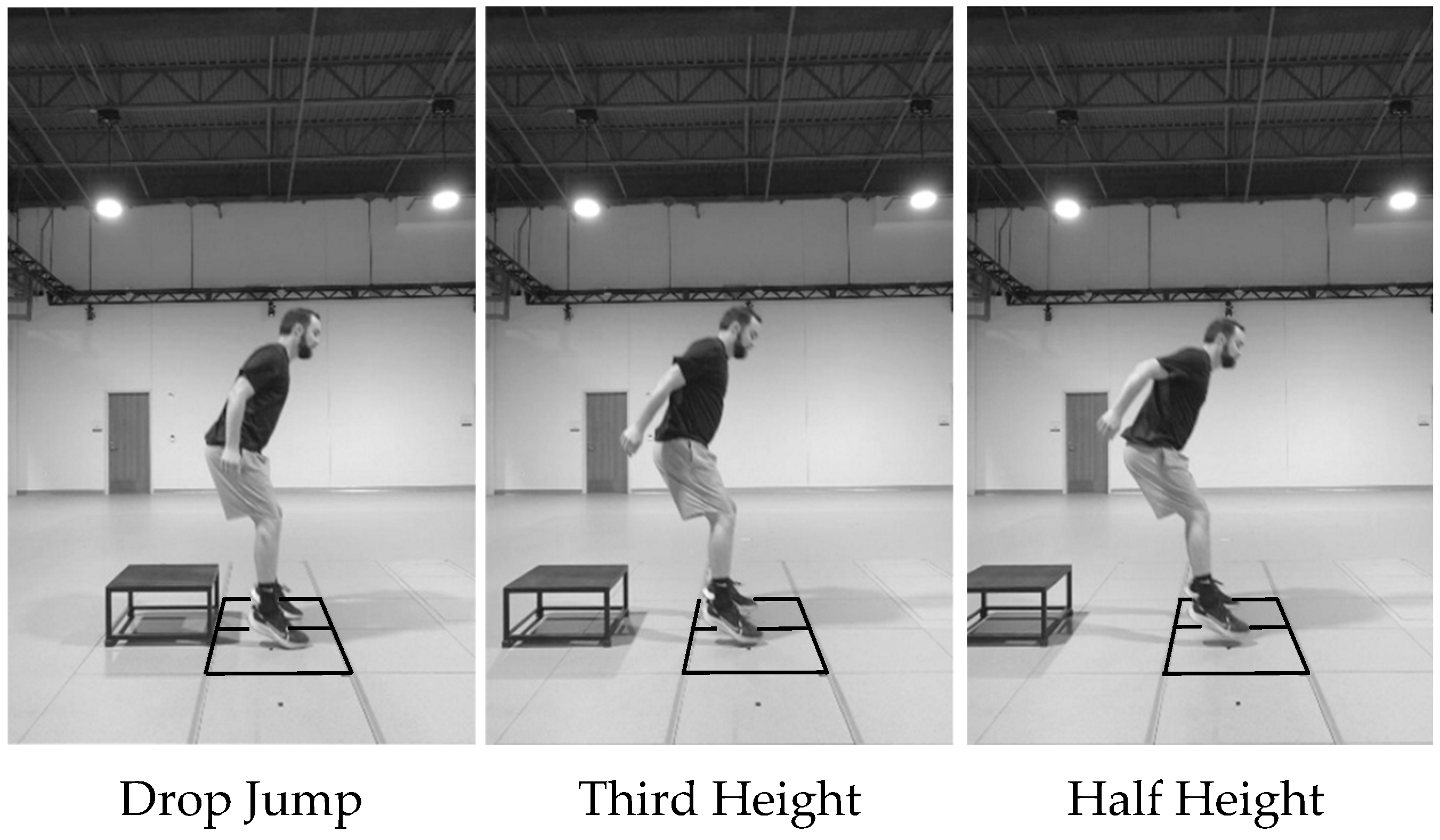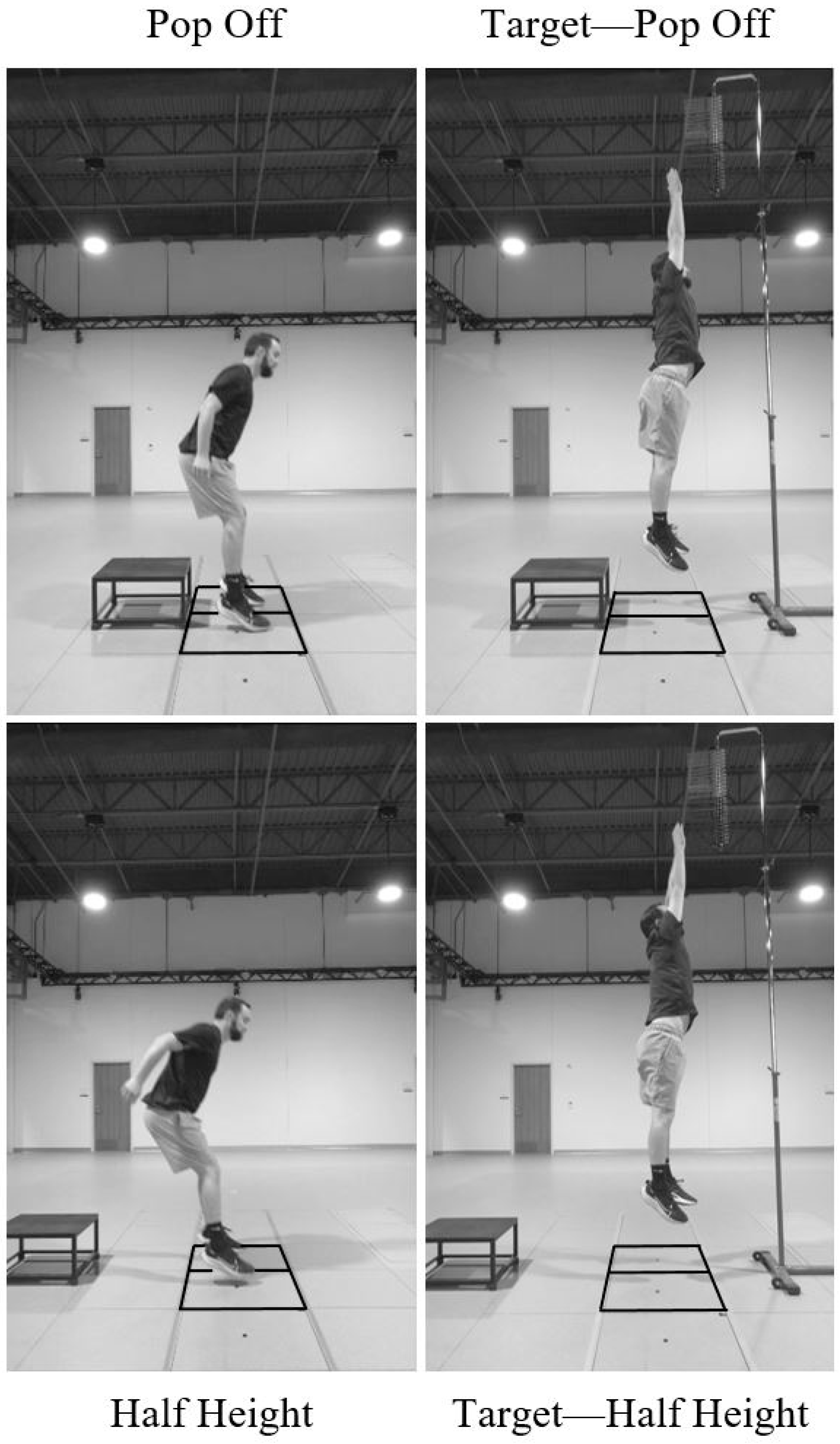The Effects of Drop Vertical Jump Task Variation on Landing Mechanics: Implications for Evaluating Limb Asymmetry
Abstract
:1. Introduction
2. Materials and Methods
2.1. Study Design and Participants
2.2. Procedures
2.3. Data Processing and Analysis
3. Results
4. Discussion
5. Conclusions
Author Contributions
Funding
Data Availability Statement
Conflicts of Interest
References
- Hewett, T.E.; Myer, G.D.; Ford, K.R.; Heidt, R.S., Jr.; Colosimo, A.J.; McLean, S.G.; van den Bogert, A.J.; Paterno, M.V.; Succop, P. Biomechanical measures of neuromuscular control and valgus loading of the knee predict anterior cruciate ligament injury risk in female athletes: A prospective study. Am. J. Sports Med. 2005, 33, 492–501. [Google Scholar] [CrossRef] [PubMed]
- Sugimoto, D.; Mattacola, C.G.; Bush, H.M.; Thomas, S.M.; Foss, K.D.; Myer, G.D.; Hewett, T.E. Preventive Neuromuscular Training for Young Female Athletes: Comparison of Coach and Athlete Compliance Rates. J. Athl. Train. 2017, 52, 58–64. [Google Scholar] [CrossRef]
- Alsubaie, S.F.; Abdelbasset, W.K.; Alkathiry, A.A.; Alshehri, W.M.; Azyabi, M.M.; Alanazi, B.B.; Alomereni, A.A.; Asiri, F.Y. Anterior cruciate ligament injury patterns and their relationship to fatigue and physical fitness levels—A cross-sectional study. Medicine 2021, 100, e24171. [Google Scholar] [CrossRef] [PubMed]
- Ulman, S.; Erdman, A.; Loewen, A.; Dressing, M.; Wyatt, C.; Oliver, G.; Butler, L.; Sugimoto, D.; Black, A.M.; Janosky, J. Concurrent Validity of Movement Screening Criteria Designed to Identify Injury Risk Factors in Adolescent Female Volleyball Players. Front. Sports Act. Living 2022, 4, 915230. [Google Scholar] [CrossRef]
- Hewett, T.E.; Myer, G.D.; Kiefer, A.W.; Ford, K.R. Longitudinal Increases in Knee Abduction Moments in Females during Adolescent Growth. Med. Sci. Sports Exerc. 2015, 47, 2579–2585. [Google Scholar] [CrossRef] [PubMed]
- Paterno, M.V.; Ford, K.R.; Myer, G.D.; Heyl, R.; Hewett, T.E. Limb asymmetries in landing and jumping 2 years following anterior cruciate ligament reconstruction. Clin. J. Sport Med. Off. J. Can. Acad. Sport Med. 2007, 17, 258–262. [Google Scholar] [CrossRef] [PubMed]
- Krosshaug, T.; Steffen, K.; Kristianslund, E.; Nilstad, A.; Mok, K.M.; Myklebust, G.; Andersen, T.E.; Holme, I.; Engebretsen, L.; Bahr, R. The Vertical Drop Jump Is a Poor Screening Test for ACL Injuries in Female Elite Soccer and Handball Players: A Prospective Cohort Study of 710 Athletes. Am. J. Sports Med. 2016, 44, 874–883. [Google Scholar] [CrossRef]
- Malloy, P.; Morgan, A.; Meinerz, C.; Geiser, C.; Kipp, K. The association of dorsiflexion flexibility on knee kinematics and kinetics during a drop vertical jump in healthy female athletes. Knee Surg. Sports Traumatol. Arthrosc. Off. J. ESSKA 2015, 23, 3550–3555. [Google Scholar] [CrossRef]
- Cortes, N.; Onate, J. Clinical assessment of drop-jump landing for determination of risk for knee injury. Int. J. Athl. Ther. Train. 2013, 18, 10–13. [Google Scholar] [CrossRef]
- Almonroeder, T.G.; Kernozek, T.; Cobb, S.; Slavens, B.; Wang, J.; Huddleston, W. Cognitive Demands Influence Lower Extremity Mechanics During a Drop Vertical Jump Task in Female Athletes. J. Orthop. Sports Phys. Ther. 2018, 48, 381–387. [Google Scholar] [CrossRef]
- Redler, L.H.; Watling, J.P.; Dennis, E.R.; Swart, E.; Ahmad, C.S. Reliability of a field-based drop vertical jump screening test for ACL injury risk assessment. Phys. Sportsmed. 2016, 44, 46–52. [Google Scholar] [CrossRef] [PubMed]
- Cruz, A.; Bell, D.; McGrath, M.; Blackburn, T.; Padua, D.; Herman, D. The effects of three jump landing tasks on kinetic and kinematic measures: Implications for ACL injury research. Res. Sports Med. 2013, 21, 330–342. [Google Scholar] [CrossRef]
- Harato, K.; Morishige, Y.; Kobayashi, S.; Niki, Y.; Nagura, T. Biomechanical features of drop vertical jump are different among various sporting activities. BMC Musculoskelet. Disord. 2022, 23, 331. [Google Scholar] [CrossRef]
- Welling, W.; Benjaminse, A.; Gokeler, A.; Otten, B. Enhanced retention of drop vertical jump landing technique: A randomized controlled trial. Hum. Mov. Sci. 2016, 45, 84–95. [Google Scholar] [CrossRef] [PubMed]
- Cesar, G.M.; Tomasevicz, C.L.; Burnfield, J.M. Frontal plane comparison between drop jump and vertical jump: Implications for the assessment of ACL risk of injury. Sports Biomech. 2016, 15, 440–449. [Google Scholar] [CrossRef] [PubMed]
- Dicesare, C.A.; Minai, A.A.; Riley, M.A.; Ford, K.R.; Hewett, T.E.; Myer, G.D. Distinct Coordination Strategies Associated with the Drop Vertical Jump Task. Med. Sci. Sports Exerc. 2020, 52, 1088–1098. [Google Scholar] [CrossRef]
- Ford, K.R.; Nguyen, A.D.; Hegedus, E.J.; Taylor, J.B. Vertical Jump Biomechanics Altered with Virtual Overhead Goal. J. Appl. Biomech. 2017, 33, 153–159. [Google Scholar] [CrossRef]
- Castagno, P.; Richards, J.G.; Miller, F.; Lennon, N. Comparison of 3-dimensional lower extremity kinematics during walking gait using two different marker sets. Gait Posture 1995, 3, 87. [Google Scholar] [CrossRef]
- Ulman, S.; Chafetz, R.; Wren, T.A.; Loewen, A.; Erdman, A.; Fischer, P.; Giampetruzzi, N.; Kanai, S.; Katzel, M.; McMulkin, M.; et al. PRiSM Motion Analysis Research Interest Group’s Sports Protocol: Knee Emphasis, Standard Operating Procedures. Gait Posture 2022, 108, 132–138. [Google Scholar] [CrossRef]
- Ford, K.R.; Myer, G.D.; Hewett, T.E. Valgus knee motion during landing in high school female and male basketball players. Med. Sci. Sports Exerc. 2003, 35, 1745–1750. [Google Scholar] [CrossRef]
- Ulman, S.; Loewen, A.M.; Erdman, A.L.; Õunpuu, S.; Chafetz, R.; Tulchin-Francis, K.; Wren, T.A.L. Lower-extremity kinematics and kinetics differ based on drop vertical jump variation: An assessment of methodology for a return-to-play protocol using motion analysis. Gait Posture 2023, 108, 132–138. [Google Scholar] [CrossRef] [PubMed]
- Padua, D.A.; Marshall, S.W.; Boling, M.C.; Thigpen, C.A.; Garrett, W.E., Jr.; Beutler, A.I. The Landing Error Scoring System (LESS) Is a valid and reliable clinical assessment tool of jump-landing biomechanics: The JUMP-ACL study. Am. J. Sports Med. 2009, 37, 1996–2002. [Google Scholar] [CrossRef] [PubMed]
- Woltring, H.J. A fortran package for generalized, cross-validatory spline smoothing and differentiation. Adv. Eng. Softw. 1986, 8, 104–113. [Google Scholar] [CrossRef]
- Tsai, L.C.; Ko, Y.A.; Hammond, K.E.; Xerogeanes, J.W.; Warren, G.L.; Powers, C.M. Increasing hip and knee flexion during a drop-jump task reduces tibiofemoral shear and compressive forces: Implications for ACL injury prevention training. J. Sports Sci. 2017, 35, 2405–2411. [Google Scholar] [CrossRef]
- Bates, N.A.; Ford, K.R.; Myer, G.D.; Hewett, T.E. Impact differences in ground reaction force and center of mass between the first and second landing phases of a drop vertical jump and their implications for injury risk assessment. J. Biomech. 2013, 46, 1237–1241. [Google Scholar] [CrossRef]
- Ford, K.R.; Myer, G.D.; Smith, R.L.; Byrnes, R.N.; Dopirak, S.E.; Hewett, T.E. Use of an overhead goal alters vertical jump performance and biomechanics. J. Strength Cond. Res. 2005, 19, 394–399. [Google Scholar] [CrossRef]


| Initial Contact | Half Height | Third Height | Drop Jump | Pop Off | Target-Half Height | Target-Pop Off | |
|---|---|---|---|---|---|---|---|
| Kinematic Angles (°) | Hip flexion | 2.2 (2.0) | 1.7 (1.7) | 7.0 (3.9) H,T | 2.8 (2.0) D | 2.5 (1.7) | 2.9 (2.6) |
| Knee flexion | 3.7 (2.6) | 4.9 (3.5) | 15.2 (9.3) H,T | 4.9 (2.9) D | 5.3 (2.5) | 5.8 (5.5) | |
| Hip adduction | 6.0 (3.5) | 4.1 (3.0) | 4.9 (4.4) | 4.2 (3.1) | 4.1 (2.0) | 3.9 (3.6) | |
| Knee abduction | 2.4 (1.8) | 2.6 (2.1) | 3.6 (2.5) H | 2.1 (1.2) D | 2.6 (1.9) | 2.1 (1.9) | |
| Hip rotation | 5.1 (3.7) | 5.7 (5.0) | 7.1 (5.8) | 5.1 (4.6) | 5.9 (5.7) | 5.4 (3.7) | |
| Knee rotation | 6.2 (4.9) | 5.3 (3.5) | 5.7 (4.96) | 4.9 (3.7) | 6.1 (3.4) | 6.2 (3.9) | |
| Kinetics Moment (Nm/kg) | Sagittal hip | 0.22 (0.25) | 0.23 (0.22) | 0.29 (0.19) | 0.16 (0.13) D | 0.20 (0.20) | 0.18 (0.16) |
| Sagittal knee | 0.10 (0.13) | 0.12 (0.11) | 0.13 (0.08) | 0.07 (0.05) D | 0.08 (0.09) | 0.08 (0.06) | |
| Coronal hip | 0.17 (0.12) | 0.13 (0.08) | 0.13 (0.11) | 0.13 (0.09) | 0.13 (0.07) | 0.09 (0.07) P | |
| Coronal knee | 0.09 (0.07) | 0.08 (0.05) | 0.08 (0.05) | 0.09 (0.05) | 0.10 (0.08) | 0.10 (0.05) | |
| Transverse hip | 0.03 (0.02) | 0.04 (0.02) | 0.04 (0.03) | 0.03 (0.02) | 0.03 (0.02) H | 0.03 (0.02) | |
| Transverse knee | 0.01 (0.01) | 0.01 (0.01) | 0.01 (0.01) | 0.01 (0.00) | 0.01 (0.01) H | 0.01 (0.01) | |
| Descent phase | Half Height | Third Height | Drop Jump | Pop Off | Target-Half Height | Target-Pop Off | |
| Kinematic Angles (°) | Hip flexion | 2.7 (2.2) | 2.5 (2.8) | 2.5 (1.6) | 2.7 (1.9) | 2.7 (1.7) | 2.5 (2.5) |
| Knee flexion | 3.1 (2.7) | 3.1 (2.4) | 2.6 (2.1) | 2.8 (1.8) | 2.8 (2.0) | 3.1 (3.1) | |
| Hip adduction | 5.5 (4.7) | 4.5 (3.5) | 4.1 (3.4) | 3.8 (3.9) | 4.8 (4.9) | 4.3 (3.9) | |
| Knee abduction | 2.6 (1.9) | 2.6 (2.0) | 3.4 (2.5) | 2.2 (1.4) D | 2.6 (1.8) | 2.3 (1.8) | |
| Hip rotation | 5.7 (4.1) | 7.4 (5.3) | 6.9 (4.9) | 4.7 (3.2) | 6.6 (4.6) | 6.9 (7.3) | |
| Knee rotation | 5.0 (4.2) | 5.3 (4.3) | 5.8 (3.9) | 5.0 (4.0) | 5.6 (4.6) | 6.3 (5.2) | |
| Kinetics Moment (Nm/kg) | Sagittal hip | 0.36 (0.21) | 0.65 (0.99) | 0.36 (0.32) | 0.22 (0.18) | 0.24 (0.23) | 0.36 (0.37) |
| Knee extensor | 0.30 (0.23) | 0.27 (0.15) | 0.28 (0.21) | 0.29 (0.20) | 0.34 (0.29) | 0.33 (0.16) | |
| Coronal hip | 0.28 (0.25) | 0.37 (0.34) | 0.278 (0.17) | 0.21 (0.16) | 0.26 (0.25) | 0.39 (0.37) | |
| Coronal knee | 0.23 (0.18) | 0.20 (0.16) | 0.18 (0.16) | 0.21 (0.17) | 0.24 (0.16) | 0.23 (0.20) | |
| Transverse hip | 0.08 (0.08) | 0.10 (0.08) | 0.09 (0.08) | 0.07 (0.08) | 0.10 (0.07) | 0.08 (0.10) | |
| Transverse knee | 0.04 (0.03) | 0.05 (0.03) | 0.06 (0.04) H | 0.05 (0.05) | 0.04 (0.04) | 0.06 (0.05) |
Disclaimer/Publisher’s Note: The statements, opinions and data contained in all publications are solely those of the individual author(s) and contributor(s) and not of MDPI and/or the editor(s). MDPI and/or the editor(s) disclaim responsibility for any injury to people or property resulting from any ideas, methods, instructions or products referred to in the content. |
© 2024 by the authors. Licensee MDPI, Basel, Switzerland. This article is an open access article distributed under the terms and conditions of the Creative Commons Attribution (CC BY) license (https://creativecommons.org/licenses/by/4.0/).
Share and Cite
Erdman, A.L.; Ulman, S.; Suzman, E.; Petric, J.K.; Loewen, A.M.; Õunpuu, S.; Chafetz, R.; Tulchin-Francis, K.; Wren, T.A.L. The Effects of Drop Vertical Jump Task Variation on Landing Mechanics: Implications for Evaluating Limb Asymmetry. Symmetry 2024, 16, 90. https://doi.org/10.3390/sym16010090
Erdman AL, Ulman S, Suzman E, Petric JK, Loewen AM, Õunpuu S, Chafetz R, Tulchin-Francis K, Wren TAL. The Effects of Drop Vertical Jump Task Variation on Landing Mechanics: Implications for Evaluating Limb Asymmetry. Symmetry. 2024; 16(1):90. https://doi.org/10.3390/sym16010090
Chicago/Turabian StyleErdman, Ashley L., Sophia Ulman, Evan Suzman, Jan Karel Petric, Alex M. Loewen, Sylvia Õunpuu, Ross Chafetz, Kirsten Tulchin-Francis, and Tishya A. L. Wren. 2024. "The Effects of Drop Vertical Jump Task Variation on Landing Mechanics: Implications for Evaluating Limb Asymmetry" Symmetry 16, no. 1: 90. https://doi.org/10.3390/sym16010090







